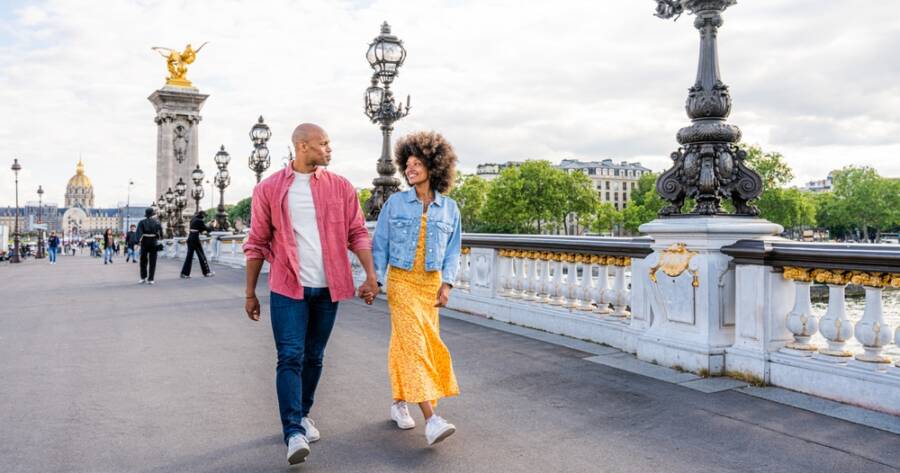Some cities are best explored one step at a time, where every corner reveals a new café, market, or tucked-away gem. Walkable cities invite you to slow down, look around, and truly connect with the place you’re in. With pedestrian-friendly streets, charming neighborhoods, and plenty to discover without ever hailing a cab, these destinations turn the simple act of walking into an adventure. Lace up your comfiest shoes–these cities are made for wandering.
Paris, France: Stroll Through Romance and History
Paris was practically made for walking. With its charming boulevards, scenic riverbanks, and hidden alleyways, the city invites you to explore at a gentle pace. From the Eiffel Tower to Montmartre, each neighborhood tells its own story–best discovered on foot. Cafés spill onto sidewalks, bookstores beckon from every corner, and unexpected courtyards seem to appear like magic.
The city’s layout makes it easy to navigate without relying on public transit. Compact arrondissements are connected by iconic bridges and wide avenues that lead you from museums to gardens without ever needing a car. Walking through Paris isn’t just transportation, it’s an experience in itself, filled with sensory moments that stay with you long after you’ve left.
Amsterdam, Netherlands: Pedestrian-Friendly With Canal-Side Charm
Amsterdam is a dream for anyone who loves to walk (and bike). Though famous for its cycling culture, the city’s compact layout, flat terrain, and stunning canal views make it ideal for exploring on foot. Each neighborhood is packed with character, from the flower-filled Jordaan district to the vibrant energy of De Pijp.
The city’s historic center is lined with cobbled streets, open-air markets, and museums that are just a few steps apart. With many streets reserved for pedestrians and cyclists, you can wander without the stress of busy traffic. And when your feet need a break, there’s always a cozy canal-side café or boat tour waiting nearby. Amsterdam moves at a perfectly walkable pace.
Venice, Italy: Get Lost in the Most Beautiful Way
Venice is a city without cars, which means walking is the only way to truly experience it. The winding alleys, stone bridges, and narrow footpaths create a maze-like layout that’s surprisingly peaceful once you surrender to the pace. It’s one of the few places where getting lost isn’t frustrating, it’s part of the magic.
From quiet canals to grand piazzas, everything is within walking distance. You can visit historic churches, admire local art, and indulge in gelato without ever needing wheels. The absence of cars creates a unique atmosphere of calm, allowing you to soak in the sounds of footsteps, water, and laughter echoing through the stone streets. Venice is made for wandering slowly and discovering something new around every turn.
Kyoto, Japan: Peaceful Paths and Cultural Wonders
Kyoto blends ancient tradition with walkable tranquility. Many of its most iconic sites (like the Arashiyama Bamboo Grove, Gion’s historic streets, and the Fushimi Inari Shrine) are best experienced on foot. The city’s neighborhoods are well-connected and designed for exploration, with plenty of temples, teahouses, and gardens to discover along the way.
Kyoto’s pedestrian-friendly streets encourage mindfulness and observation. Whether you’re wandering through a quiet Zen garden or strolling past paper lanterns at night, every path invites reflection. Side streets often reveal local markets, hidden shrines, and family-run noodle shops you’d never find in a guidebook. For travelers who appreciate calm, beauty, and slow travel, Kyoto is a dream come true.
Melbourne, Australia: Culture, Coffee, and Hidden Laneways
Melbourne is one of the most walkable cities in Australia, with a downtown grid that’s incredibly easy to navigate. The best part? The city is full of laneways—narrow, mural-covered alleys packed with independent shops, lively cafés, and some of the best coffee in the world. Each block offers something new to explore on foot.
Public art, pop-up performances, and eclectic markets keep your walks interesting, while green spaces like the Royal Botanic Gardens offer a peaceful break just outside the urban center. Melbourne also has an extensive network of trams, but walking gives you the best chance to take it all in—from street art to surprise rooftop bars. It’s a city that rewards curiosity with every step.
Lisbon, Portugal: Hills, Views, and Cobbled Streets
Lisbon’s steep hills might make you pause, but the rewards are well worth the effort. The city’s maze of cobbled streets, pastel buildings, and scenic overlooks are best appreciated slowly and on foot. Each neighborhood–from the historic Alfama to the lively Bairro Alto–offers its own rhythm and style, easily explored one step at a time.
The city’s compact nature allows you to walk between major landmarks, bakeries (hello, pastéis de nata), and riverside promenades with ease. Trams and elevators can help when you need a break from the hills, but the best moments in Lisbon are the ones you stumble upon while walking: a hidden viewpoint, a charming courtyard, or a live Fado performance drifting through an open window.
Let the Streets Lead the Way
There’s something incredibly freeing about exploring a place on foot. Without the rush of transit or the distractions of traffic, you notice more–architecture, music, smells, and subtle details that bring a city to life. T
hese walkable destinations invite you to slow down and engage with the world in a more meaningful way. Whether you’re wandering canals, crossing cobbled lanes, or pausing to admire street art, walking connects you deeply to the soul of a city—and to your own sense of wonder.

